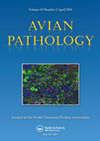High pathogenicity avian influenza H5N1 clade 2.3.4.4b natural infection in captive Humboldt penguins (Spheniscus humboldti).
IF 2.2
2区 农林科学
Q1 VETERINARY SCIENCES
引用次数: 0
Abstract
Research highlights: Natural HPAIV H5N1 infection causes mortality and pathology in Humboldt penguins.Molecular analysis identified the aetiology as a novel H5N1 clade 2.3.4.4b genotype.Immunohistochemical analysis demonstrated infection of endothelial cells, macrophages and reticular cells in lymphoid tissue.
洪堡企鹅自然感染高致病性H5N1进化枝2.3.4.4b
在2020年至2023年期间,高致病性禽流感病毒(HPAIV) H5Nx分支2.3.4.4b在欧洲和英国的家禽和野生鸟类种群中造成了毁灭性的爆发。在2022年冬季,在英国动物园收集的14只户外圈养洪堡企鹅中,有4只意外死亡,没有事先的临床症状。已将拭子、一具整尸及两具头送交应呈报禽流感实验室调查。兽医病理学家使用既定的死后程序检查了临床材料,并根据标准的应通报禽流感检测算法收集组织进行正式抽样。采用实时反转录PCR、全基因组测序、组织病理学和免疫组织化学对选定的组织进行检测。在对H5N1感染进行分子检测后,在抽样的12只动物中有5只发现阳性结果。大体检查胴体,发现全身充血。组织病理学显示坏死和急性炎症,主要发生在脾、肝和肺。免疫组化显示内皮细胞和淋巴样细胞中存在病毒抗原,尤其是肺、脾、肝、脑和心肌。这一发现强烈提示内皮细胞和淋巴样细胞是洪堡企鹅感染HPAIV的主要目标。分子鉴定鉴定病原体为HPAIV H5N1分支2.3.4.4b,根据英国方案基因分型为AIV223。这是英国首次记录到这种基因型。这些发现为这种病毒在自然感染的圈养洪堡企鹅中的病理生物学提供了新的见解。研究强调自然HPAIV H5N1感染导致洪堡企鹅死亡和病理。分子分析鉴定病原学为H5N1新分支2.3.4.4b基因型。免疫组化分析显示淋巴组织内皮细胞、巨噬细胞和网状细胞感染。
本文章由计算机程序翻译,如有差异,请以英文原文为准。
求助全文
约1分钟内获得全文
求助全文
来源期刊

Avian Pathology
农林科学-兽医学
CiteScore
4.50
自引率
10.70%
发文量
68
审稿时长
1 months
期刊介绍:
Avian Pathology is the official journal of the World Veterinary Poultry Association and, since its first publication in 1972, has been a leading international journal for poultry disease scientists. It publishes material relevant to the entire field of infectious and non-infectious diseases of poultry and other birds. Accepted manuscripts will contribute novel data of interest to an international readership and will add significantly to knowledge and understanding of diseases, old or new. Subject areas include pathology, diagnosis, detection and characterisation of pathogens, infections of possible zoonotic importance, epidemiology, innate and immune responses, vaccines, gene sequences, genetics in relation to disease and physiological and biochemical changes in response to disease. First and subsequent reports of well-recognized diseases within a country are not acceptable unless they also include substantial new information about the disease or pathogen. Manuscripts on wild or pet birds should describe disease or pathogens in a significant number of birds, recognizing/suggesting serious potential impact on that species or that the disease or pathogen is of demonstrable relevance to poultry. Manuscripts on food-borne microorganisms acquired during or after processing, and those that catalogue the occurrence or properties of microorganisms, are unlikely to be considered for publication in the absence of data linking them to avian disease.
 求助内容:
求助内容: 应助结果提醒方式:
应助结果提醒方式:


